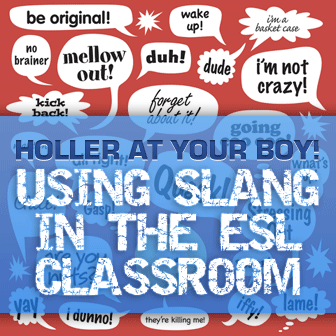Holler at Your Boy! Using Slang in the ESL Classroom


Using slang is one primary way for students to test the waters of fluency and begin communicating in expressions as native speakers do. Apply these 3 strategies to help students interpret the cumbersome world of slang.

It's very useful for students to hear slang terminology in natural speech at a regular speed. To do this, speak to students using a number of expressions without defining the new language concepts. Present slang in context using stories and examples and do your best not to slow down your speech. Always speak to them in a conversational tone utilizing a number of slang words and phrases. Students should listen to see how many expressions they can pick out of your story, and how accurately they can piece them together. Chances are when you first start presenting slang this way, they will miss several words or phrases entirely or record them incorrectly. This is normal and once they see how many they missed or misheard, they will be that much more interested in doing better the next time. Don't let missing expressions hinder their confidence, especially if you have littered your story with phrases they have never heard before.
Give students time to compare their answers in small groups or pairs. Students can spend time discussing what they heard and the possible meanings. After they have determined what they heard, they can then begin to pick apart the expressions, and attempt their own examples of how to use each slang expression. This is a lot to accomplish, so you may want to split it into two parts so students aren't overwhelmed. You could also go over the answers as a group and then have them reconvene into their groups to determine their individual examples for new phrases.
Comprehension checks are vital as students are learning how to practically apply the slang they are learning. Doing comprehension checks ensures that students not only understand the expression, but also have a good idea of how and when to use it. There are a lot of ways to reinforce the new vocabulary and highlight practical use. Quizzes assembled in various ways can be used so that students can gage their own progress, and the quizzes don't have to be overly-serious or stress-inducing. Think about ways to create and go through quizzes that will be memorable and entertaining. One way to do this is to have students take a short quiz independently and then assemble them into groups for the correction and explanation of the quiz. Provide twists to correction, like handing out poker chips or fake money to have each team bet on how successful they believe their answer is before the answer is provided. For multiple choice quizzes, try forming two teams and do a race to the right answer. In this instance, one team must be the first to respond to the question by buzzer or hands, and then before they provide the correct answer, they must first dispel each answer that is incorrect.
Using new slang situationally is a wonderful comprehension check as well as a way to review lots of new vocabulary. A good stand alone activity is to provide them with situations and have students role play or create short conversations on the spot. You could use cards with various situations and hand them out to small groups or pairs. Then ask students to conversationally insert the slang they have learned where appropriate. Your situations could be things like:
Students will enjoy using the new words and phrases, and may begin correcting one another, incorporating slang into daily use, or asking for more and more and more.
Where can you find a lot of natural language usage that also exposes students to other accents, faster language, and unlimited slang? Movies and TV are a wonderful resource for any teacher tackling slang, and with the addition of the internet everything you might be looking for is right at your fingertips. Look for TV shows that are popular with students to engage them, challenge their listening, and provide memorable clips with humor. Sitcoms are perfect for one-on-one slang usage, and you can create whole lessons around one or two clips. Using movies may take a little more prep time, but if you happen to have a class that loves to watch movies, it's a great way to have them listen for new language and have ready-made situational examples to refer to. Animated films are a good choice, or dramas that have a lot of dialogue and not much action. Stay away from raunchy comedies, complex thrillers, and action movies with little speaking. Some great movie options are: When Harry Met Sally, Sleepless in Seattle, Runaway Bride, and Father of the Bride.
Movies and TV provide a great resource to display natural language, and also to focus on relationships, conversations in general, and conflicts. Students will pick out a lot of interesting language, not just slang and they will enjoy being able to sit back and watch language in action. Be sure to always have goal-driven lead-in and wrap-up exercises, possible fill-in-the-blanks, and discussion topics that weave in the slang and situations that were approached. Experiment with what works best, and you might just find your advanced students asking to view an entire movie or episode.
Give them the tools to decipher slang for themselves by employing these strategies that are sure to get them slinging slang in no time.